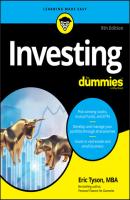Investing For Dummies. Eric Tyson
Чтение книги онлайн.

Читать онлайн книгу Investing For Dummies - Eric Tyson страница 20
Название: Investing For Dummies
Автор: Eric Tyson
Издательство: John Wiley & Sons Limited
Жанр: Личные финансы
isbn: 9781119716518
isbn:
A 30-year-old wanting to accumulate $500,000 by age 65 would need to save $440 per month if she earns a 5 percent average annual return, but she needs to save only $170 per month if she earns a 9 percent average return per year. Younger investors need to pay the most attention to the risk of generating low returns, but so should younger senior citizens. At the age of 65, seniors need to recognize that a portion of their assets may not be used for a decade or more from the present.
INFLATION RAGIN’ OUTTA CONTROL
You think 6, 8, or 10 percent annual inflation rates are bad? How would you like to live in a country that experienced that rate of inflation in a day? Too much money in circulation chasing after too few goods causes high rates of inflation.
A government that runs amok with the nation’s currency and money supply usually causes excessive rates of inflation — dubbed hyperinflation. Over the decades and centuries, hyperinflation has wreaked havoc in more than a few countries.
What happened in Germany in the late 1910s and early 1920s demonstrates how bad hyperinflation can get. Consider that during this time period, prices increased nearly one-billionfold! What cost 1 Reichsmark (the German currency in those days) at the beginning of this mess eventually cost nearly 1 billion Reichsmarks. People had to cart around so much currency that at times they needed wheelbarrows to haul it! Ultimately, this inflationary burden was too much for the German society, creating a social climate that fueled the rise of the Nazi party and Adolf Hitler.
During the 1990s, a number of countries, especially many that made up the former USSR and others such as Brazil and Lithuania, got themselves into a hyperinflationary mess with inflation rates of several hundred percent per year. In the mid-1980s, Bolivia’s yearly inflation rate exceeded 10,000 percent.
Governments often try to slap on price controls to prevent runaway inflation (President Richard Nixon did this in the United States in the early 1970s), but the underground economy, known as the black market, usually prevails.
Career risk
If you don’t continually invest in your education, you risk losing your competitive edge. Your skills and perspectives can become dated and obsolete. Although that doesn’t mean you should work 80 hours a week and never do anything fun, it does mean that part of your “work” time should involve upgrading your skills.
The best organizations are those that recognize the need for continual knowledge and invest in their workforce through training and career development. Just remember to consider your own career objectives, which may not be the same as your company’s.
Analyzing Returns
When you choose investments, you have the potential to make money in a variety of ways. Each type of investment has its own mix of associated risks that you take when you part with your investment dollar and, likewise, offers a different potential rate of return. In the following sections, I cover the returns you can expect with each of the common investing avenues. But first, I walk you through the components of calculating the total return on an investment.
The components of total return
To figure out exactly how much money you’ve made (or lost) on your investment, you need to calculate the total return. To come up with this figure, you need to determine how much money you originally invested and then factor in the other components, such as interest, dividends, and appreciation (or depreciation).
If you’ve ever had money in a bank account that pays interest, you know that the bank pays you a small amount of interest when you allow it to keep your money. The bank then turns around and lends your money to some other person or organization at a much higher interest rate. The rate of interest is also known as the yield. So if a bank tells you that its savings account pays 2 percent interest, the bank may also say that the account yields 2 percent. Banks usually quote interest rates or yields on an annual basis. The interest that you receive is one component of the return you receive on your investment.
If a bank pays monthly interest, the bank also likely quotes a compounded effective annual yield. After the first month’s interest is credited to your account, that interest starts earning interest as well. So the bank may say that the account pays 2 percent, which compounds to an effective annual yield of 2.04 percent.
When you lend your money directly to a company — which is what you do when you invest in a bond that a corporation issues — you also receive interest. Bonds, as well as stocks (which are shares of ownership in a company), fluctuate in value after they’re issued.
When you invest in a company’s stock, you hope that the stock increases (appreciates) in value. Of course, a stock can also decline, or depreciate, in value. This change in market value is part of your return from a stock or bond investment:
For example, if one year ago you invested $10,000 in a stock (you bought 1,000 shares at $10 per share) and the investment is now worth $11,000 (each share is worth $11), your investment’s appreciation looks like this: